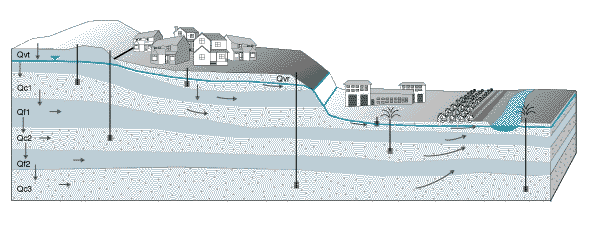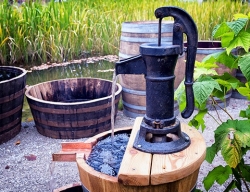Private Water Supply
What is a private water supply?
In Tennessee, about 10 percent of the population uses a private water supply as their source of drinking and household water. Private water supplies in Tennessee are usually a groundwater well or a spring. Private water supplies are, for the most part, unregulated. How a private well is constructed is regulated, but the quality of the water coming from that well is not regulated. Water from springs is also not regulated. The Tennessee Department of Environment and Conservation’s Division of Water Resources handles most water supply issues in Tennessee.
The U.S. Environmental Protection Agency estimates 42 million Americans (mostly in rural America) get their water from private wells or other small, unregulated water systems. According to the 2003 American Housing Survey of 105 million homes in the United States, about 13 million (12.4 percent) had wells. The three common types of water wells are drilled, dug or driven.


Health concerns regarding private water supplies
Water from private water supplies is often untested and contaminated.
Groundwater tends to be of better quality than surface water. Still, groundwater may be contaminated with chemicals like petroleum, solvents, or metals and biological pathogens like viruses, parasites or bacteria. Water supply wells that are dug rather than drilled or driven tend to use shallow water and, like surface water, are more likely to be contaminated. EPA’s publication Drinking Water From Household Wells has more information on private water wells. Tennessee has many areas with what is known as “karst topography.” These areas are characterized by a limestone landscape with caves, fissures and underground streams. In karst areas, wells of any type can pose a health risk because the water is under the direct influence of surface water and is more easily contaminated from runoff. Water in karst areas can flow very quickly, allowing it to move chemical and biological contaminants long distances.
With few exceptions, surface water and groundwater sources should be presumed to have bacterial contamination and should be disinfected. Bacteriological testing of well water should be done with several samples taken over a period of time to establish a history. TDEC’s Division of Water Resources recommends private water supplies be tested for bacteria every year. For information on how to test your home’s water, contact an approved laboratory.
Well water should also be tested for chemical contamination every two years including nitrates and metals. If you live near an industrial area, you should test for volatile organic compounds every several years.
If the indoor air in your home has tested high for radon, you should also test your private water supply for radon. EPA’s Drinking Water website provides additional information on conditions that might prompt you to test your well water. Always have test results interpreted and explained to you by a staff member of TDEC’s Division of Water Resources at 1-800-523-4873, or call EPA’s Safe Drinking Water Hotline at 1-800-426-4791.
Depending on the results of these water tests, a water treatment system may be necessary. Consult the TDEC DWR program about your test results at 1-888-891-TDEC (8332) or consult with the Private Well Owner website or their telephone hotline at 1-855-420-9355 to determine the best treatment option for your water.
The Centers for Disease Control and Prevention has new guidance on Groundwater Corrosivity and Lead in Private Wells.
Planning a new well
Quantity and quality of groundwater varies considerably across Tennessee. A licensed driller or a representative of TDEC DWR can help determine the prospects for using groundwater in your area. Requirements for new wells can be found in the Water Well Licensing Regulaltions and Well Construction Standards.
When planning to install a new water well, the location should be a safe distance from potential sources of contamination. The following distances of separation are required by Tennessee regulation (TCA 1200-4-9-.10):
Potential Sources of Contamination Minimum Distances
Sewage Lagoons; Leaching Pits 200 feet
Animal Pens; Feed Lots 100 feet
Sludge; Sewage Disposal Sites 100 feet
Pit Privies 75 feet
Sewer Lines 50 feet
Septic Tanks; Drain Fields 50 feet
House to Septic Tank Connections (Tightline) 10 feet
Other sources of potential contamination include petroleum, pesticides or fertilizers. Underground storage tanks (USTs) are often used to store petroleum products. If a storage tank leaks underground, it can easily contaminate a water supply. Water wells should also be placed away from areas where pesticides or fertilizers are stored or handled. EPA recommends a minimum distance of 100 feet between your water source and USTs or pesticide/fertilizer storage and handling areas. If the area of well construction has any sources of chemical contamination nearby, consider relocating the well in consultation with a licensed well driller or TDEC DWR staff.
The casing of a well should be sealed with grout or another mastic material to ensure surface water does not seep along the well casing to the water source. The well site should not be subject to flooding. If site conditions make it necessary to construct a well in an area subject to flooding, the watertight casing should extend at least two feet above the 100-year flood elevation.
Wells should be at least five feet away from any overhanging rooftops or power lines and should not be constructed in pits, basements or areas where future construction may take place. The ground should slope away from the top of your well. For a well on a hillside, the uphill side of the well should be designed to prevent runoff from entering the well. A well should be located at least ten feet away from a property line.
After the installation of a new well, Tennessee water well construction standards require both the driller and pump installer to disinfect the well. A strong chlorine solution will kill most bacteria in a well if allowed to remain for at least 12 hours. To disinfect the well, pour into the well one gallon of chlorine bleach or one ounce HTH super chlorinated solution for every 50 feet of well depth. Once the chlorine is in the well, the faucets in the home should run until a chlorine odor is noticed. The water is then turned off and allowed to remain in the well and pipes for at least 12 hours. After 12 hours, faucets should be turned on and water allowed to flow until the chlorine odor is gone. When pumping this heavily chlorinated water out of the well, don’t discharge it through a septic system or a natural body of water such as a stream or lake. The disinfection procedure should be repeated each time the well, pump or pipes are serviced.
Protecting the quality of your groundwater supply
- Inspect exposed parts of wells periodically for cracked, corroded or damaged well casings; broken or missing well caps; and settling and cracking of surface seals. This is important to remember immediately following natural disasters such as tornados and wildfires. For more information on how to protect your water well following a wildfire see, Is My Private Well Safe After a Fire?, Returning Home After a Wildfire and Well Water safety After a Fire.
- Slope the area around your well to drain surface runoff away from the well.
- Install a well cap or sanitary seal to prevent unauthorized use of, or entry into, your well.
- Test once a year for coliform bacteria, nitrates and other constituents of concern.
- Keep accurate records of any well maintenance, such as disinfection or sediment removal, that require the use of chemicals in the well.
- Hire a certified well driller for new well construction, modification or abandonment and closure.
- Avoid mixing or using pesticides, fertilizers, herbicides, degreasers, fuels or other possible pollutants near wells or springs.
- Do not dispose of waste in dry or abandoned wells.
- Do not cut off well casings below the land surface.
- Pump and inspect septic systems as often as recommended by groundwater protection specialists.
- Never dispose of hazardous materials such as paints, paint strippers, floor stripper compounds or excess fuels or parts cleaners into a septic system.

Additional resources
Tennessee Department of Health
Healthy Homes
Centers for Disease Control and Prevention (CDC)
Healthy Housing Reference Manual
http://www.tn.gov/environment/program-areas/wr-water-resources/water-quality/well-water
Water Systems Council - Well Owner's Manual
U.S. Geological Survey-Learn About Water
U.S. Geological Survey-Quality of Water from Domestic Wells in the United States
Centers for Disease Control and Prevention-Private Ground Water Wells
